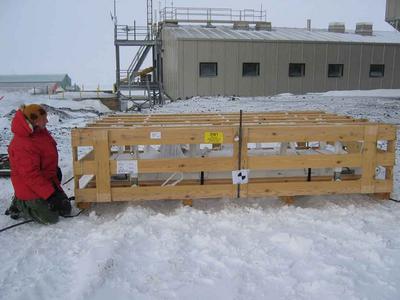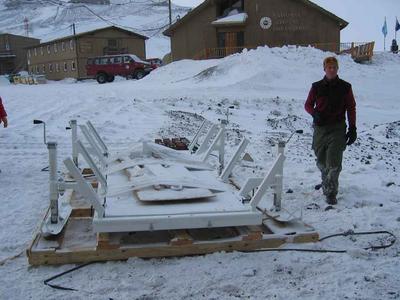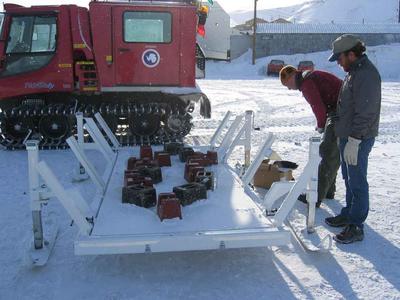
|
|
23 October, 2003
The morning's mission was to uncrate the 800 lb weighing sled and
make sure it had survived its long trip from Fort Collins, Colorado
to McMurdo, Antarctica. This was one of the better-constructed crates
you may ever have to dismantle. Armed with pry bars and hammers, we
spent an aerobic hour removing sides and top to reveal the gleaming
white sled within.
This sled, built in Fort Collins, was designed by Darren after last
year's field season. The sled that he had used was too cumbersome in
the field-it's weight and the difficulty of setting it up to give
accurate measurements kept him from collecting as much data as he
would have liked for his mass dynamics project. This new sled was
designed to be relatively lightweight yet strong, with a steel
framework and aluminum weighing platform mounted on steel skis for
ease of transport behind a pisten bully or snowmobile. Each of its 4
legs is adjustable using trailer jacks so that the scale can be
leveled before use. The platform uses the same weighing mechanism
that is used to weigh cattle. It has a digital readout that averages
the weights received by the 4 corner-mounted sensors.
Once we had the sled out of the crate, it was time to calibrate the
scale. The Crary Lab has a set of 16 metal weights, each weighing
56 lbs. Why 56 lbs, you might ask. I don't know-could it be because
56 is such an easy number to multiply in your head? Our first chore
was to lug all the weights inside to a digital scale to make sure
that they did, indeed, each weigh 56lbs. They were all within an
ounce or so of the promised weight. Then we brought them back
outside to the sled and put them on top of the weighing platform.
Quickly now, do the math in your head, 16 x 56 = ? . Following along
in the instruction manual, Darren set the scale to 896 lbs. Then,
the fun began. We removed one weight, and the scale's readout was
only 20 lbs less. We removed another weight and found that it was
now 150 lbs less. Something was not right. So, it was time to take
all the weights off the scale and try putting one on at a time.
Okay, one 56 lb weight isŠ120 lbs. Add a second one and you getŠ150
lbs. Obviously, something was not working properly. We tried
re-reading the instructions, re-calibrating the scale, and
re-leveling the weighing sled. After much head-scratching and
bewilderment we admitted defeat.
While the scale had been tested back in Fort Collins, it was apparent
that there were definitely some differences in how it worked at 72F
and how it worked at 5F. Science is about asking questions and
developing hypotheses based on those questions. Was the problem
mechanical or electrical? That was Darren's mission for the
afternoon. The sled was moved to a heated workspace so he could spend
the afternoon identifying and fixing the problem.
Daily Haiku:
Calibrate the sled
Weights on, weights off, one more time
Why doesn't it work?

Getting ready to uncrate the sled

The crate is removed, now we're ready to set-up the sled

Calibrating the sled with our 56 lb weights
Contact the TEA in the field at
.
If you cannot connect through your browser, copy the
TEA's e-mail address in the "To:" line of
your favorite e-mail package.
|
